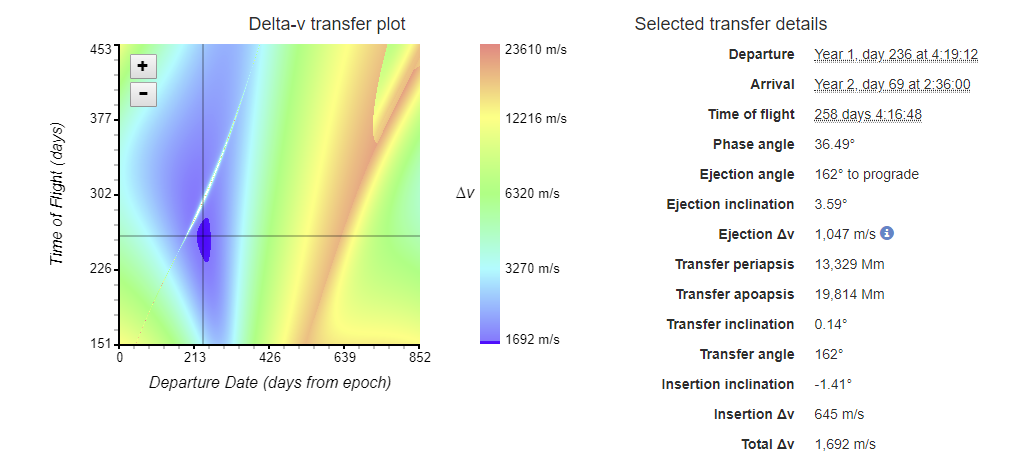Ksp Delta V Map
Cheat sheet kerbal space program wiki kerbal space program rocket scientist s cheat sheet delta v maps equations and more for your reference so you can from here to there and back again 1 3 munity delta v map 2 6 sep 29th tutorials but because the chart posted above isn t very easy reading i took the liberty to edit wac s subway style delta. You should really calculate this yourself. Here’s a popular delta-V map that tells you every number you’re going to need. Some extremely bad and quick back-of-the-napkin math shows you’re going to need at least (and probably more) 32,000 delta-V t.
- Ksp Delta V Map 1.10
- Ksp Delta V Map 1.8
- Transfer Window Planner Ksp
- Ksp Delta V Map 1.10
- Ksp Delta V Map
- Ksp Delta V Map How To Read
View Delta V Map Ksp Images. Fury road,gaming,kerbal space program,ksp,compilation,clips,gifs,funny,silly,cool,random,mods,explosion,swdennis,kerbals,in,danger,destruction,weird,stuff,pc,jebediah,crash,test,parts,stock,weapon,bd armory,destroy,cannon,gun. Elliptical 13600 mm low orbit.
Ksp Delta V Map 1.10
Kerbal delta v map posted by zoey johnson. The achievable change in velocity in metres per second. 904 x 640 png 435 кб.
Pdf versions (a4 & letter).
Third tutorial in a long series. The achievable change in velocity in metres per second. Back then the options were limited, but in the years since the team who makes ksp possible have been hard at work to produce a. Pdf versions (a4 & letter).
Kerbal Space Program rocket scientist's cheat sheet: Delta-v maps, equations and more for your reference so you can get from here to there and back again.
- 1Mathematics
- 1.3Delta-v (Δv)
- 2Math examples
Mathematics
Thrust-to-weight ratio (TWR)
- → See also: Thrust-to-weight ratio
This is Newton's Second Law. If the ratio is less than 1 the craft will not lift off the ground. Note that the local gravitational acceleration, which is usually the surface gravity of the body the rocket is starting from, is required.
- is the thrust of the engines
- the total mass of the craft
- the local gravitational acceleration (usually surface gravity)
Combined specific impulse (Isp)
- → See also: Specific impulse
If the Isp is the same for all engines in a stage, then the IspAshlee morales hit by drunk driver for mac. is equal to a single engine. If the Isp is different for engines in a single stage, then use the following equation:
Nov 03, 2019 Download E-Transcript Bundle Viewer for free. E-Transcript Bundle Viewer - Used by more than 70% of the court reporting industry, RealLegal E-Transcript technology is the benchmark for electronic transcripts, and the standard delivery format for litigators nationwide. Just like with the popular Adobe PDF Viewer, after you have downloaded the E-Transcript Viewer once, you can open any RealLegal E-Transcript file you receive. Westlaw Case Notebook Portable E- Transcript Professional grade application available for your iPad or iPhone.  Looking for help with any of the RealLegal products? Give us a call or browse the resources below. 1-800-290-9378 offers support for all RealLegal products, including: West Publisher, E-Transcript, LiveNote Stream, and Case Notebook. This option includes the free E-Transcript Bundle Viewer to display the transcripts, exhibits, links, and video. When the disc is inserted into a computer, the bundle automatically opens in the free viewing software and everything in the bundle can be viewed and saved.
Looking for help with any of the RealLegal products? Give us a call or browse the resources below. 1-800-290-9378 offers support for all RealLegal products, including: West Publisher, E-Transcript, LiveNote Stream, and Case Notebook. This option includes the free E-Transcript Bundle Viewer to display the transcripts, exhibits, links, and video. When the disc is inserted into a computer, the bundle automatically opens in the free viewing software and everything in the bundle can be viewed and saved.
Delta-v (Δv)
Basic calculation
- → See also: Tutorial:Advanced Rocket Design
Basic calculation of a rocket's Δv. Use the atmospheric and vacuum thrust values for atmospheric and vacuum Δv, respectively.
- is the velocity change possible in m/s
- is the starting mass in the same unit as
- is the end mass in the same unit as
- is the specific impulse of the engine in seconds
True Δv of a stage that crosses from atmosphere to vacuum
| Body | Δvout |
|---|---|
| Kerbin | 2500 m/s |
| other bodies' data missing | |
Calculation of a rocket stage's Δv, taking into account transitioning from atmosphere to vacuum. Δvout is the amount of Δv required to leave a body's atmosphere, not reach orbit. This equation is useful to figure out the actual Δv of a stage that transitions from atmosphere to vacuum.
Ksp Delta V Map 1.8
Maps

Various fan-made maps showing the Δv required to travel to a certain body.
Subway style Δv map (KSP 1.2.1):
Total Δv values
Δv change values
Δv with Phase Angles
Precise Total Δv values
WAC's Δv Map for KSP 1.0.4
Maximum Δv chart
- This chart is a quick guide to what engine to use for a single stage interplanetary ship. No matter how much fuel you add you will never reach these ΔV without staging to shed mass or using the slingshot maneuver. (These calculations use a full/empty fuel-tank mass ratio of 9 for all engines except those noted.)
| ISP(Vac) (s) | Max Δv (m/s) | Engines | Remarks |
|---|---|---|---|
| 250 | 5249 | O-10 'Puff' | Monopropellant (max full/empty mass ratio = 8.5) |
| 290 | 6249 | LV-1R 'Spider' 24-77 'Twitch' | |
| 300 | 6464 | KR-1x2 'Twin-Boar' | |
| 305 | 6572 | CR-7 R.A.P.I.E.R. Mk-55 'Thud' | |
| 310 | 6680 | LV-T30 'Reliant' RE-M3 'Mainsail' | |
| 315 | 6787 | LV-1 'Ant' KS-25 'Vector' KS-25x4 'Mammoth' | |
| 320 | 6895 | 48-7S 'Spark' LV-T45 'Swivel' RE-I5 'Skipper' | |
| 340 | 7326 | KR-2L+ 'Rhino' T-1 'Dart' | |
| 345 | 7434 | LV-909 'Terrier' | |
| 350 | 7542 | RE-L10 'Poodle' | |
| 800 | 17238 | LV-N 'Nerv' | |
| 4200 | 58783 | IX-6315 'Dawn' | Xenon (max full/empty mass ratio = 4.167) |
(Version: 1.6.1)
Math examples
TWR
- Copy template:
- TWR = F / (m * g) > 1
Transfer Window Planner Ksp
Isp
- When Isp is the same for all engines in a stage, then the Isp is equal to a single engine. So six 200 Isp engines still yields only 200 Isp.
- When Isp is different for engines in a single stage, then use the following equation:

- Equation:
- Simplified:
- Isp = ( F1 + F2 + .. ) / ( ( F1 / Isp1 ) + ( F2 / Isp2 ) + .. )
- Explained:
- Isp = ( Force of thrust of 1st engine + Force of thrust of 2nd engine..and so on.. ) / ( ( Force of thrust of 1st engine / Isp of 1st engine ) + ( Force of thrust of 2nd engine / Isp of 2nd engine ) + ..and so on.. )
Ksp Delta V Map 1.10
- Example:
- Two engines, one rated 200 newtons and 120 seconds Isp ; another engine rated 50 newtons and 200 seconds Isp.
- Isp = (200 newtons + 50 newtons) / ( ( 200 newtons / 120 ) + ( 50 newtons / 200 ) = 130.4347826 seconds Isp
Δv
- For atmospheric Δv value, use atmospheric values.
- For vacuum Δv value, use vacuum values.
- Use this equation to figure out the Δv per stage:
- Equation:
Ksp Delta V Map
- Simplified:
- Δv = ln ( Mstart / Mdry ) * Isp * g
Ksp Delta V Map How To Read
- Explained:
- Δv = ln ( starting mass / dry mass ) X Isp X 9.81
- Example:
- Single stage rocket that weighs 23 tons when full, 15 tons when fuel is emptied, and engine that outputs 120 seconds Isp.
- Δv = ln ( 23 Tons / 15 Tons ) × 120 seconds Isp × 9.81m/s² = Total Δv of 503.0152618 m/s
Maximum Δv
- Simplified version of the Δv calculation to find the maximum Δv a craft with the given ISP could hope to achieve. This is done by using a magic 0 mass engine and not having a payload.
- Equation:


- Simplified:
- Δv =21.576745349086 * Isp
- Explained / Examples:
- This calculation only uses the mass of the fuel tanks and so the ln ( Mstart / Mdry ) part of the Δv equation has been replaced by a constant as Mstart / Mdry is always 9 (or worse with some fuel tanks) regardless of how many fuel tanks you use.
- The following example will use a single stage and fuel tanks in the T-100 to Jumbo 64 range with an engine that outputs 380 seconds Isp.
- Δv = ln ( 18 Tons / 2 Tons ) × 380 seconds Isp × 9.81m/s² = Maximum Δv of 8199.1632327878 m/s
- Δv = 2.1972245773 × 380 seconds Isp × 9.82m/s² = Maximum Δv of 8199.1632327878 m/s (Replaced the log of mass with a constant as the ratio of total mass to dry mass is constant regardless of the number of tanks used as there is no other mass involved)
- Δv = 21.576745349086 × 380 seconds Isp = Maximum Δv of 8199.1632327878 m/s (Reduced to its most simple form by combining all the constants)
True Δv
- How to calculate the Δv of a rocket stage that transitions from Kerbin atmosphere to vacuum.
- Assumption: It takes roughly 2500 m/s of Δv to escape Kerbin's atmosphere before vacuum Δv values take over for the stage powering the transition (actual value ranges between 2000 m/s and 3400 m/s depending on ascent). Note that, as of KSP 1.3.1, around 3800 m/s of Δv is required to reach an 80km orbit from the KSC.
- Note: This equation is a guess, an approximation, and is not 100% accurate. Per forum user stupid_chris who came up with the equation: 'The results will vary a bit depending on your TWR and such, but it should usually be pretty darn accurate.'
- Equation for Kerbin atmospheric escape:
- Simplified:
- True Δv = ( ( Δv atm - 2500 ) / Δv atm ) * Δv vac + 2500
- Explained:
- True Δv = ( ( Total Δv in atmosphere - 2500 m/s) / Total Δv in atmosphere ) X Total Δv in vacuum + 2500
- Example:
- Single stage with total atmospheric Δv of 5000 m/s, and rated 6000 Δv in vacuum.
- Transitional Δv = ( ( 5000 Δv atm - 2500 Δv required to escape Kerbin atmosphere ) / 5000 Δv atm ) X 6000 Δv vac + 2500 Δv required to escape Kerbin atmosphere = Total Δv of 5500 m/s